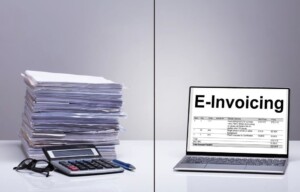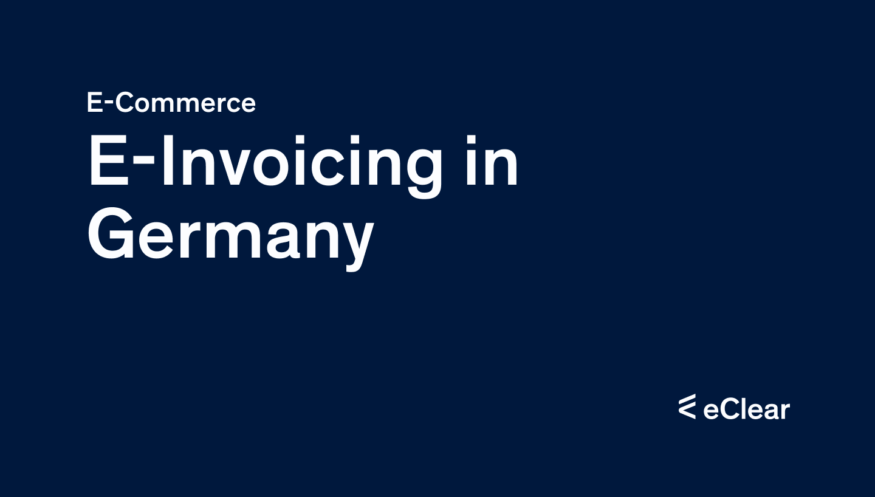Definition and meaning of e-invoicing
E-invoicing is the electronic invoice exchange between companies and their business partners. Instead of printed paper invoices, invoice data is transmitted electronically, which enables efficient processing and automated handling. This leads to accelerated payment processing and improved business management processes.
E-invoicing is essential because it simplifies the invoice process, reduces manual tasks, and improves accuracy. By using electronic invoices, businesses can save time and money by minimising the manual effort involved in creating and processing invoices. In addition, e-invoicing enables better traceability and transparency of the invoice process.

The Shift from Traditional Invoicing to E-Invoicing in Germany
Germany has been progressively transitioning from traditional paper-based invoicing to electronic invoicing, or e-invoicing. This shift is part of a broader digital transformation trend reshaping business operations across various sectors. E-invoicing, which involves exchanging invoice information between a supplier and a buyer in an integrated electronic format, offers several advantages over traditional invoicing, including cost savings, faster processing times, and reduced errors.
The Role of the European Directive 2014/55/EU in Promoting E-Invoicing
The European Directive 2014/55/EU has played a significant role in promoting the adoption of e-invoicing in Germany and across Europe. The directive mandates using e-invoicing in public procurement processes to standardise e-invoicing formats and facilitate cross-border public procurement transactions. The directive has been instrumental in driving the shift towards e-invoicing in Germany, particularly in the Business-to-Government (B2G) sector.
E-Invoicing Compliance and Latest Developments
Compliance is crucial to the success of e-invoicing. Companies should keep abreast of current developments and regulatory changes to ensure their e-invoicing practices align with legal requirements. What exactly does the application currently look like in practice? E-invoicing is mainly applied in the following areas:
Government-to-Citizen (G2C)
“XRechnung”, or XInvoice, is a standardised electronic invoice format that has been in use in Germany since November 27, 2020. This format is mandatory for any entity conducting business with public contracting authorities. The XInvoice format, based on the European standard EN16931, facilitates the electronic exchange of invoice data between companies and public clients. Its primary purpose is to streamline communication, enhance the efficiency and accuracy of the invoicing process, and ensure the inclusion of essential information. This mandatory information includes details about the invoicing party, the invoice recipient, the invoice number, the date, and the item data. Public sector clients must accept and process XInvoices, leading to increased efficiency, reduced errors, and improved transparency in tax collection.
Business-to-Government (B2G)
The Business-to-Government (B2G) sector shifts have been primarily driven by the European Directive 2014/55/EU. This directive mandates using e-invoicing in public procurement processes to standardise e-invoicing formats and facilitate cross-border public procurement transactions. Individual federal states in Germany have been implementing e-invoicing requirements since April 2020, each setting specific requirements for the format and transmission method of e-invoices.
Business-to-Business (B2B)
The Value Added Tax Act (UStG) regulates electronic invoicing in Germany. Currently, e-invoicing in the B2B sector is voluntary, but there are plans to make it mandatory by 2025. The European Commission has authorised Germany to introduce e-invoicing in the B2B sector from January 1, 2025, to December 31, 2027.
Various models are being considered for the step-by-step implementation of e-invoicing, including the “5-corner” model via PEPPOL and a model involving private providers. PEPPOL, an acronym for “Pan-European Public Procurement On-Line”, has gained significance recently. As a result, many European and international companies and public authorities are issuing and receiving invoices exclusively in electronic form. The COVID-19 pandemic has expedited this transition.
Various technical standards and formats are used, such as XInvoice, EDI (Electronic Data Interchange), and ZUGFeRD. The latter is a standardised file format for electronic invoices in Germany that combines a PDF file with structured invoice data in XML format, facilitating the exchange and automated processing of invoices between companies and public authorities.
Business-to-Consumer (B2C)
In Germany, electronic invoicing in the Business-to-Consumer (B2C) sector is not currently regulated by specific laws. The decision to implement e-invoicing is primarily a business choice. However, it’s crucial to consider that not all customers may be equipped to receive electronic invoices.
Business-to-Government (B2G)
Implementing electronic invoicing in the Business-to-Government (B2G) sector in Germany is a part of the execution of the European Directive 2014/55/EU. Since April 18, 2020, individual federal states in Germany have been setting and implementing specific requirements for the format and transmission method of e-invoices.
Certain federal states have already established specific dates for the mandatory introduction of e-invoicing for suppliers to public contracting authorities. For instance, Mecklenburg-Western Pomerania has mandated e-invoicing from April 1, 2023, with Hesse and Rhineland-Palatinate following suit from January 1, 2024.
Companies operating in the B2G sector need to be fully aware of the requirements set by their respective federal states. They must format and transmit their e-invoices by these stipulations to meet the legal requirements.
Legal Requirements and Regulatory Framework
E-invoicing in Germany is subject to specific legal requirements and regulatory frameworks. For instance, the Value Added Tax Act (UStG) regulates the requirements for electronic invoices, including necessary invoice information and storage obligations. The German proper accounting principles (GoBD) define electronic accounting and archiving needs. Companies must understand and comply with these regulations to avoid legal consequences. A thorough understanding of the legal framework ensures the legal certainty and integrity of the e-invoicing process.
Advantages of e-invoicing
E-invoicing offers various benefits for businesses:
Time and cost savings: e-invoicing reduces the manual workload and speeds up invoicing, resulting in significant time and cost savings.
Improved accuracy: Automated data exchange minimises errors due to manual input, resulting in increased invoice accuracy and precision.
Traceability and transparency: e-invoicing enables better traceability of invoice status and increased transparency throughout the invoice process.
Disadvantages of e-invoicing
Although e-invoicing offers mainly advantages, there are, unfortunately, also potential disadvantages that should be considered:
Security risks: Electronic invoices are vulnerable to security threats such as hacking and data manipulation. Companies need to implement adequate security measures to ensure the confidentiality and integrity of invoice data.
Technical standards and formats: E-invoicing requires compliance with specific technical standards and formats to ensure smooth integration with business partners’ systems. This may require additional adjustments and investments.

Which e-invoicing methods are used?
EDI (Electronic Data Interchange): A standardised electronic data exchange that enables structured business data in a standardised format between business partners.
XML (Extensible Markup Language): A flexible file format that represents structured data in a readable and machine-readable format and facilitates the exchange of invoice data between different systems.
PDF (Portable Document Format): A method by which invoices are created and sent as PDF files. PDF invoices can be both human-readable and machine-readable.
ZUGFeRD (Central User Guide of the Electronic Invoice Forum Germany): A standardised file format that combines PDF files with embedded structured invoice data in XML format.
XRechnung: A standardised electronic invoice format in Germany based on the European standard EN16931 and used to exchange invoice data with public clients.
CSV (Comma-Separated Values): A file format that stores data in text form and structures it using separators such as commas.
API (Application Programming Interface): A method by which companies can connect their applications or systems directly to their business partners’ invoicing systems and transfer invoice data automatically.
Email: A simple method by which invoices are sent electronically via email as an attachment.

E-Invoicing Implementation: Practical Tips
Selecting the Right Software Provider: It’s crucial to choose an e-invoicing software provider that meets your specific needs and is also compatible with the technical standards in your industry. The software should be reliable, user-friendly, and capable of integrating with your existing systems.
Employee Training: E-invoicing can bring significant changes to your business processes. Therefore, it’s essential to provide adequate training to your employees. They should understand the intricacies of e-invoicing, including how to use the software and comply with the relevant standards and regulations.
Compliance with Data Protection: E-invoicing involves handling sensitive data, so ensuring your processes comply with all data protection regulations is critical. This includes the General Data Protection Regulation (GDPR) requirements, which mandate strict controls over personal data collection, storage, and use.
Regular Review and Adjustment: The world of e-invoicing is dynamic, with legal requirements and industry standards frequently changing. Reviewing your e-invoicing processes helps ensure that you remain compliant with these changes. If discrepancies are found during these reviews, adjustments should be made promptly to maintain compliance and efficiency.
Conclusion:
E-invoicing has now become an essential part of the modern business world. It enables companies to reduce costs, increase efficiency and optimise cash flow. Automating the invoicing process helps minimise errors and increase accuracy. In addition, e-invoicing promotes transparency, traceability, and auditability of transactions, which allows businesses and governments to tax collection. Taxes can be collected more efficiently through the electronic exchange of invoice data, reducing the risk of tax evasion. The continued development of technologies and standards is expected to advance e-invoicing further and streamline the invoicing process for businesses and governments.








